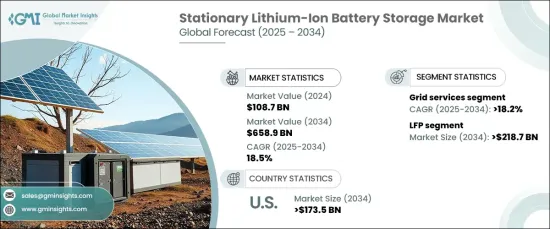 |
市場調查報告書
商品編碼
1665377
固定式鋰離子電池儲存市場機會、成長動力、產業趨勢分析及 2025 - 2034 年預測Stationary Lithium-Ion Battery Storage Market Opportunity, Growth Drivers, Industry Trend Analysis, and Forecast 2025 - 2034 |
||||||
2024 年全球固定式鋰離子電池儲存市場價值為 1,087 億美元,預計將經歷令人矚目的成長,2025 年至 2034 年的複合年成長率為 18.5%。鋰離子電池因其高能量密度、可擴展性和效率而受到認可,使其成為電網穩定、調峰和備用電源解決方案的首選。隨著風能、太陽能等再生能源的不斷擴大,對可靠的能源儲存解決方案的需求變得更加重要,以解決能源間歇性問題並確保穩定的電力供應。

在不同的鋰離子化學材料中,磷酸鐵鋰 (LFP) 部分預計到 2034 年將達到 2,187 億美元。它們的抗過熱性能使其成為大規模、長時間儲能系統的理想選擇。此外,與其他電池化學成分相比,它們的高充電和放電效率以及較小的環境影響正在推動其在永續能源應用中的採用。
| 市場範圍 | |
|---|---|
| 起始年份 | 2024 |
| 預測年份 | 2025-2034 |
| 起始值 | 1087億美元 |
| 預測值 | 6589億美元 |
| 複合年成長率 | 18.5% |
在應用方面,隨著再生能源使用量的不斷增加,對穩定可靠電網的需求不斷成長,預計到 2034 年電網服務領域將以 18.2% 的複合年成長率成長。鋰離子電池透過提供頻率調節、電壓穩定和峰值負載管理等服務在支援電網方面發揮著至關重要的作用。它們的快速反應時間和運作效率對於平衡能源供需波動至關重要,使其成為電網現代化和維護不可或缺的一部分。
在美國,固定式鋰離子電池儲存市場預計到 2034 年將創收 1,735 億美元。鋰離子電池擴大用於調峰、備用電源和電網穩定等應用,從而能夠高效地儲存再生能源產生的能量。政府的優惠政策和電池成本的下降正在推動電池的採用,使美國成為全球市場的重要參與者。
目錄
第 1 章:方法論與範圍
- 市場定義
- 基礎估算與計算
- 預測計算
- 資料來源
- 基本的
- 次要
- 有薪資的
- 民眾
第 2 章:執行摘要
第 3 章:產業洞察
- 產業生態系統分析
- 監管格局
- 產業衝擊力
- 成長動力
- 產業陷阱與挑戰
- 成長潛力分析
- 波特的分析
- 供應商的議價能力
- 買家的議價能力
- 新進入者的威脅
- 替代品的威脅
- PESTEL 分析
第4章:競爭格局
- 戰略儀表板
- 創新與永續發展格局
第 5 章:市場規模與預測:依化學成分,2021 – 2034 年
- 主要趨勢
- 低功率電源
- 奈及利亞汽車製造商協會
- 其他
第 6 章:市場規模與預測:按應用,2021 – 2034 年
- 主要趨勢
- 電網服務
- 儀表後面
- 離網
第 7 章:市場規模與預測:按地區,2021 – 2034 年
- 主要趨勢
- 北美洲
- 美國
- 加拿大
- 墨西哥
- 歐洲
- 英國
- 法國
- 德國
- 義大利
- 俄羅斯
- 西班牙
- 亞太地區
- 中國
- 澳洲
- 印度
- 日本
- 韓國
- 中東和非洲
- 沙烏地阿拉伯
- 阿拉伯聯合大公國
- 土耳其
- 南非
- 埃及
- 拉丁美洲
- 巴西
- 阿根廷
第8章:公司簡介
- BYD
- Exide
- GS Yuasa
- Hitachi
- Johnson Controls
- Leclanche
- LG Chem
- Panasonic
- Siemens
- SK Innovation
- Tesla
- Toshiba
- Varta
The Global Stationary Lithium-Ion Battery Storage Market was valued at USD 108.7 billion in 2024 and is projected to experience impressive growth, with a CAGR of 18.5% from 2025 to 2034. This growth is largely driven by the increasing focus on renewable energy integration and the modernization of power grids. Lithium-ion batteries are recognized for their high energy density, scalability, and efficiency, making them a preferred choice for grid stabilization, peak shaving, and backup power solutions. As renewable energy sources, including wind and solar, continue to expand, the demand for reliable energy storage solutions becomes even more critical to address energy intermittency and ensure a steady power supply.

Among the different lithium-ion chemistries, the lithium iron phosphate (LFP) segment is expected to reach USD 218.7 billion by 2034. LFP batteries are becoming increasingly popular due to their exceptional safety features, extended cycle life, and impressive thermal stability. Their resistance to overheating makes them ideal for large-scale, long-duration energy storage systems. Furthermore, their high charge and discharge efficiency, along with a lower environmental impact compared to other battery chemistries, is driving their adoption in sustainable energy applications.
| Market Scope | |
|---|---|
| Start Year | 2024 |
| Forecast Year | 2025-2034 |
| Start Value | $108.7 Billion |
| Forecast Value | $658.9 Billion |
| CAGR | 18.5% |
In terms of application, the grid services segment is anticipated to grow at a CAGR of 18.2% through 2034, spurred by the growing demand for stable and reliable power grids as renewable energy use continues to rise. Lithium-ion batteries play a vital role in supporting the grid by providing services like frequency regulation, voltage stabilization, and peak load management. Their rapid response times and operational efficiency are essential for balancing fluctuations in energy supply and demand, making them an integral part of modernizing and maintaining power grids.
In the United States, the stationary lithium-ion battery storage market is expected to generate USD 173.5 billion by 2034. This growth is supported by the increased adoption of renewable energy and ongoing grid modernization efforts. Lithium-ion batteries are increasingly being used for applications such as peak shaving, backup power, and grid stabilization, enabling the efficient storage of energy generated from renewable sources. Favorable government policies and falling battery costs are boosting adoption, positioning the U.S. as a key player in the global market.
Table of Contents
Chapter 1 Methodology & Scope
- 1.1 Market definitions
- 1.2 Base estimates & calculations
- 1.3 Forecast calculation
- 1.4 Data sources
- 1.4.1 Primary
- 1.4.2 Secondary
- 1.4.2.1 Paid
- 1.4.2.2 Public
Chapter 2 Executive Summary
- 2.1 Industry synopsis, 2021 – 2034
Chapter 3 Industry Insights
- 3.1 Industry ecosystem analysis
- 3.2 Regulatory landscape
- 3.3 Industry impact forces
- 3.3.1 Growth drivers
- 3.3.2 Industry pitfalls & challenges
- 3.4 Growth potential analysis
- 3.5 Porter's analysis
- 3.5.1 Bargaining power of suppliers
- 3.5.2 Bargaining power of buyers
- 3.5.3 Threat of new entrants
- 3.5.4 Threat of substitutes
- 3.6 PESTEL analysis
Chapter 4 Competitive landscape, 2024
- 4.1 Strategic dashboard
- 4.2 Innovation & sustainability landscape
Chapter 5 Market Size and Forecast, By Chemistry, 2021 – 2034 (USD Million & MW)
- 5.1 Key trends
- 5.2 LFP
- 5.3 NMC
- 5.4 Others
Chapter 6 Market Size and Forecast, By Application, 2021 – 2034 (USD Million & MW)
- 6.1 Key trends
- 6.2 Grid services
- 6.3 Behind the meter
- 6.4 Off grid
Chapter 7 Market Size and Forecast, By Region, 2021 – 2034 (USD Million & MW)
- 7.1 Key trends
- 7.2 North America
- 7.2.1 U.S.
- 7.2.2 Canada
- 7.2.3 Mexico
- 7.3 Europe
- 7.3.1 UK
- 7.3.2 France
- 7.3.3 Germany
- 7.3.4 Italy
- 7.3.5 Russia
- 7.3.6 Spain
- 7.4 Asia Pacific
- 7.4.1 China
- 7.4.2 Australia
- 7.4.3 India
- 7.4.4 Japan
- 7.4.5 South Korea
- 7.5 Middle East & Africa
- 7.5.1 Saudi Arabia
- 7.5.2 UAE
- 7.5.3 Turkey
- 7.5.4 South Africa
- 7.5.5 Egypt
- 7.6 Latin America
- 7.6.1 Brazil
- 7.6.2 Argentina
Chapter 8 Company Profiles
- 8.1 BYD
- 8.2 Exide
- 8.3 GS Yuasa
- 8.4 Hitachi
- 8.5 Johnson Controls
- 8.6 Leclanche
- 8.7 LG Chem
- 8.8 Panasonic
- 8.9 Siemens
- 8.10 SK Innovation
- 8.11 Tesla
- 8.12 Toshiba
- 8.13 Varta





